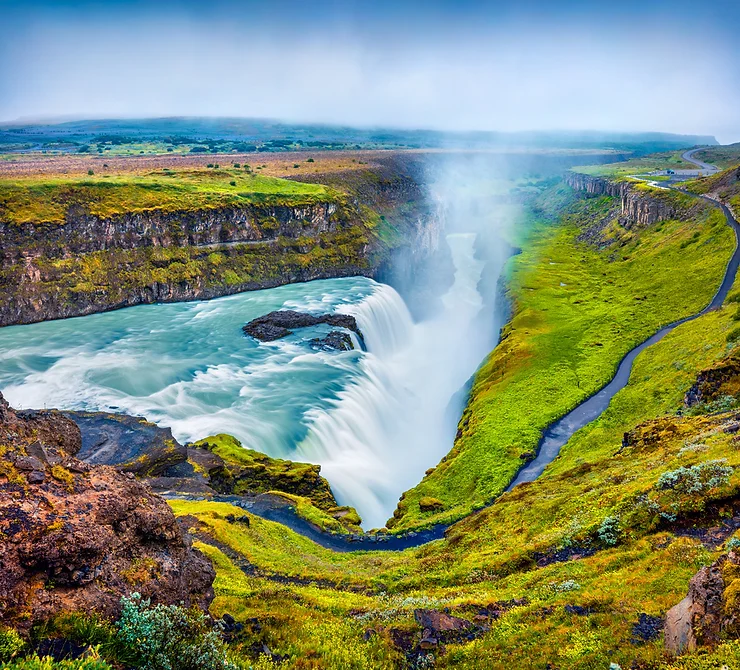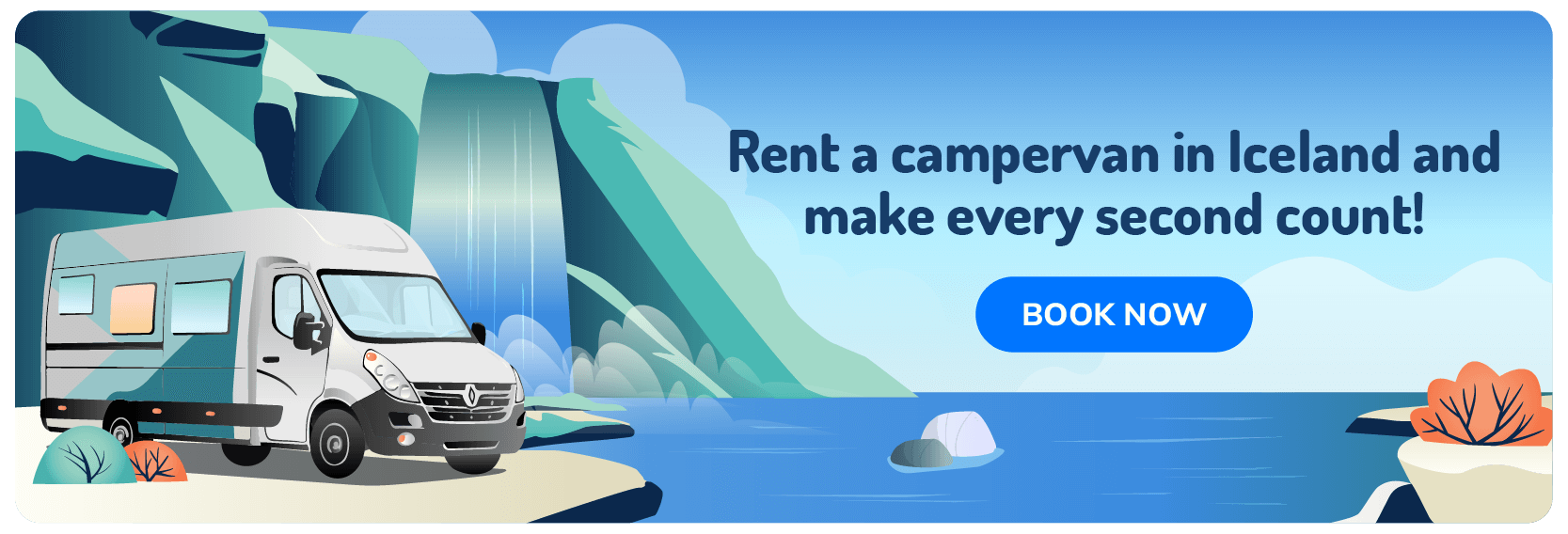Iceland is famous for its dramatic landscapes, but our waterfalls steal the show. And guess what is the best way to see them? With a campervan, of course. No rigid schedules, no overpriced tours, just you, the open road, and the best waterfalls in Iceland right outside your door.
Some are an easy stroll from the parking lot, while others make you earn the view with a bit of a hike. A few will also demand a proper 4x4. This guide breaks it all down: where to go, how to get there, and where to park your home on wheels for the night.
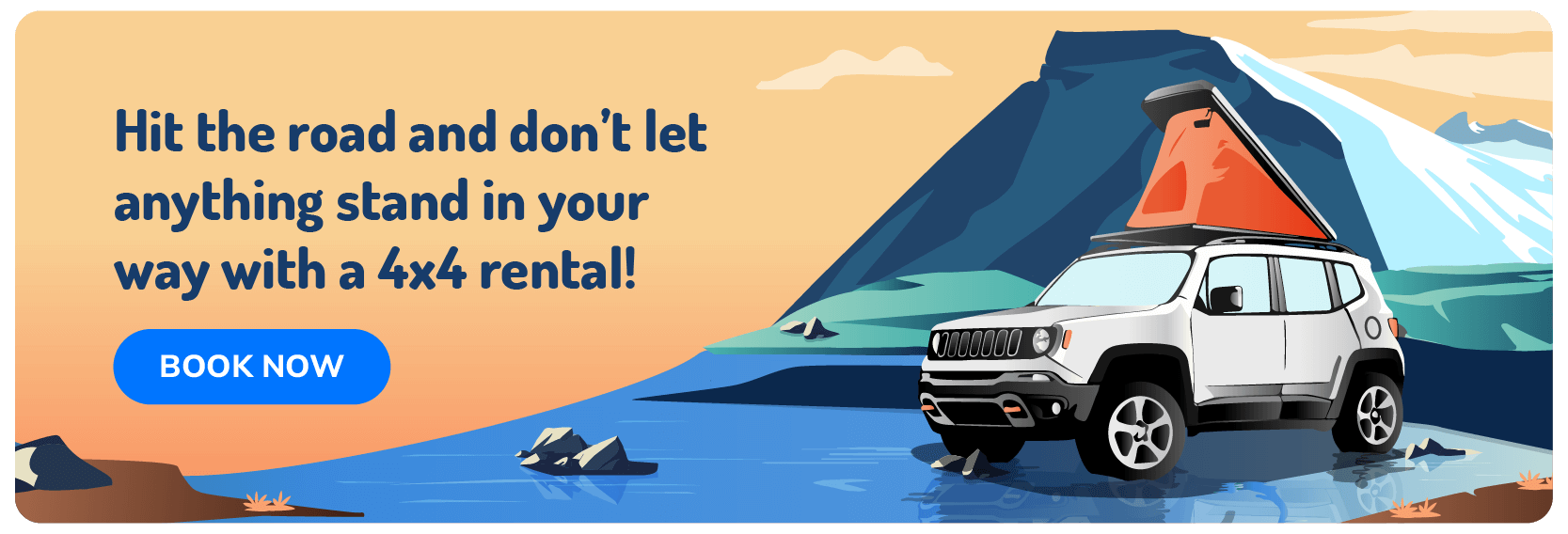
Why a Campervan is the Best Way to See Iceland's Waterfalls
Iceland is packed with waterfalls, but they are not exactly lined up along the Ring Road, waiting for you. Some are easy stops, others demand a detour, and a few make you question if you are even on the road at all. With a campervan, none of that matters. You go where you want when you want.
Instead of driving hours back to town, you can park near a waterfall, crack open a drink, and wake up with mist on your face instead of traffic noise. No backtracking, no rushing, just you and the open road.
How a Campervan Gives You Full Flexibility
Timing is everything. Some waterfalls look their best when bathed in soft morning light. Others come alive after a fresh downpour. With a campervan, you are not stuck visiting at the 'wrong' time just because a tour bus says so. If a spot is packed with tourists waving selfie sticks, you can move on and circle back later. If a waterfall blows your mind, stay as long as you want.
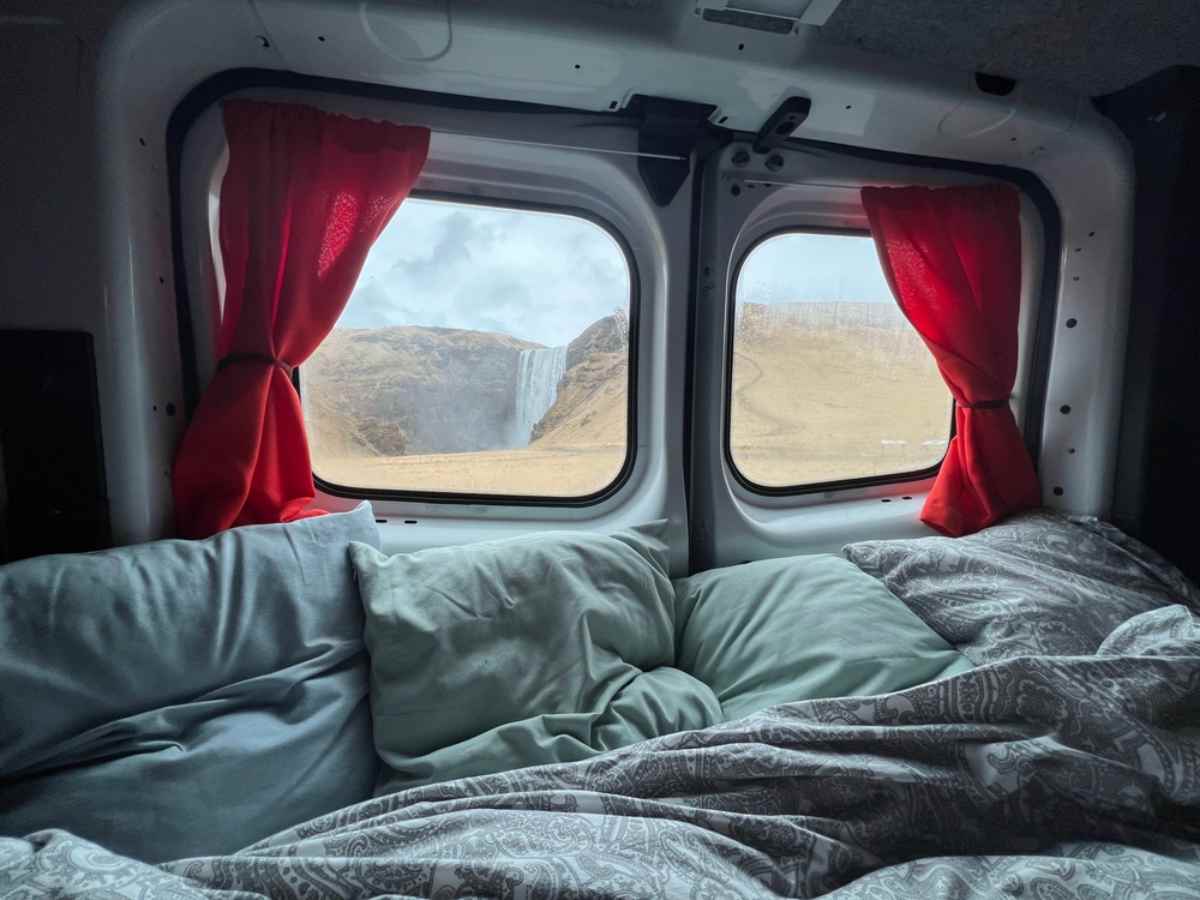
Then there is food. Iceland is not exactly known for cheap eats, and eating at roadside restaurants for every meal will drain your wallet fast. With a campervan, you are the chef. Cooking on the road beats overpaying for a sad, overpriced sandwich. Throw together something quick, eat when you feel like it, and skip the whole '$20 for a gas station snack' nonsense.
When is the Best Time to Visit Iceland's Waterfalls?
Seasons in Iceland do more than just change the temperature. They completely remix the experience of seeing waterfalls. One month, they are thundering powerhouses; the next, they are frozen in time. Here is how it plays out:
- Summer (June to August) – Melted glaciers mean waterfalls at full blast. Long daylight hours let you explore as much as you want, but you will have to share the views with plenty of other travelers.
- Autumn (September to November) – Fewer tourists, cooler air, and early glimpses of the Northern Lights. Some rain, but nothing that will ruin your trip unless you forget to pack a decent rain jacket.
- Winter (December to February) – Snow, ice, and waterfalls look like something out of a fantasy movie. Fewer crowds, but some roads will be closed, so plan ahead unless you enjoy surprise detours.
Which Campervan is Right for You?
Choosing the right campervan in Iceland depends on where you are going and how much comfort you want. Some waterfalls are easy to access, while others demand a 4x4 to handle Iceland’s rugged roads. Here is a quick breakdown of some of the most popular campervans that we offer to help you pick the best ride for your trip.
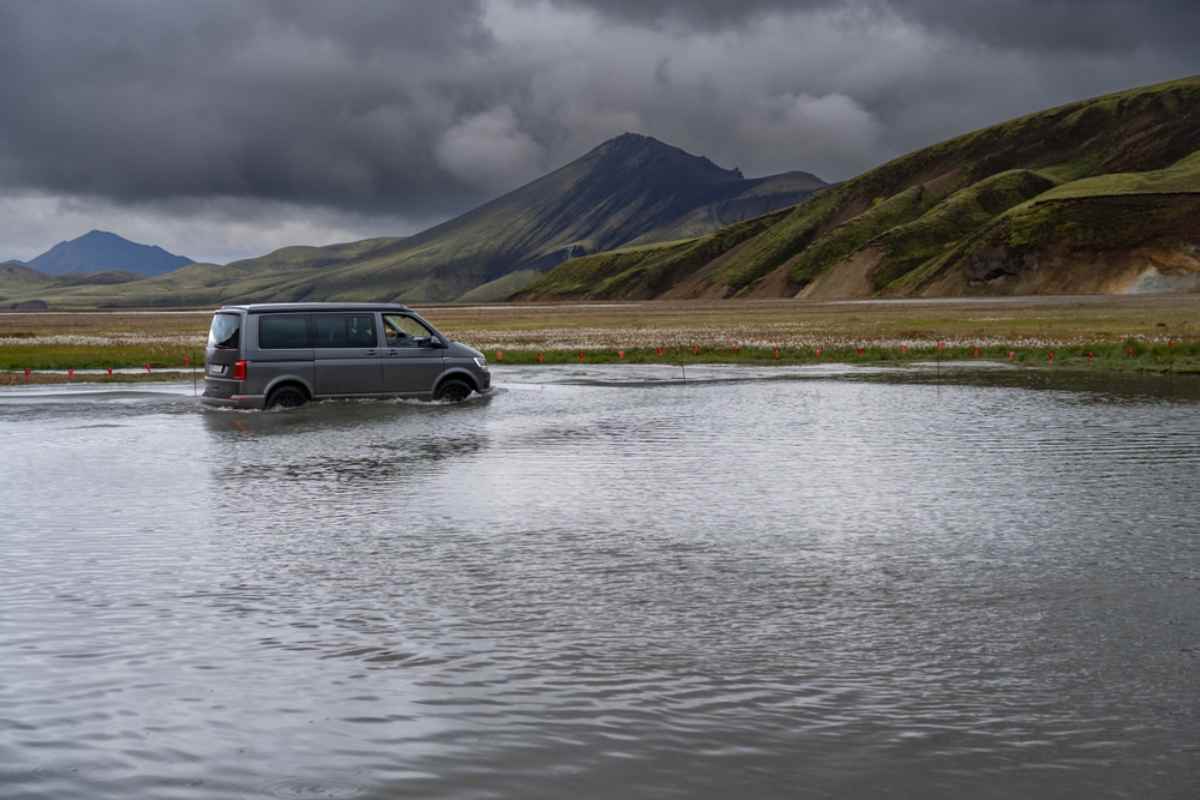
For F-Roads and Highland Adventures
If you are heading to waterfalls like Haifoss or Aldeyjarfoss, you need a 4x4 campervan. These roads can be rough, and a regular van will not survive.
- Dacia Duster 4x4 Roof Tent (manual) – Budget-friendly, seats 5, sleeps 2 and can handle F-roads. A solid choice if you do not mind a manual transmission.
- Jeep Compass 4x4 Roof Tent (automatic) – More comfort than the Duster, automatic transmission, and F-road approved. Seats 4, sleeps 2.
- Toyota Hilux 4x4 Camper (automatic) – The ultimate off-road camper. Seats 4, sleeps 4, and is fully equipped for rugged conditions. If you want space and adventure, this is the one.
For Easy Waterfall Road Trips
If your trip is mostly paved roads, and you are visiting waterfalls like Gullfoss, Seljalandsfoss, or Skogafoss, a standard campervan will be fine.
- VW Caddy Camper (automatic) – Seats 5, sleeps 2 and is easy to drive. Ideal for couples or solo travelers who want a hassle-free experience.
- Renault Trafic Roof Tent (manual) – Sleeps 4 and seats 4, but not suitable for F-roads. Great for groups sticking to well-paved routes.
Which One Should You Choose?
- Sticking to the Ring Road and main waterfalls? Go for the VW Caddy or Renault Trafic.
- Want to reach remote, F-road-accessible waterfalls? The Dacia Duster is the best value, while the Jeep Compass offers more comfort.
- Need space for a family or group? The Toyota Hilux is your best bet.
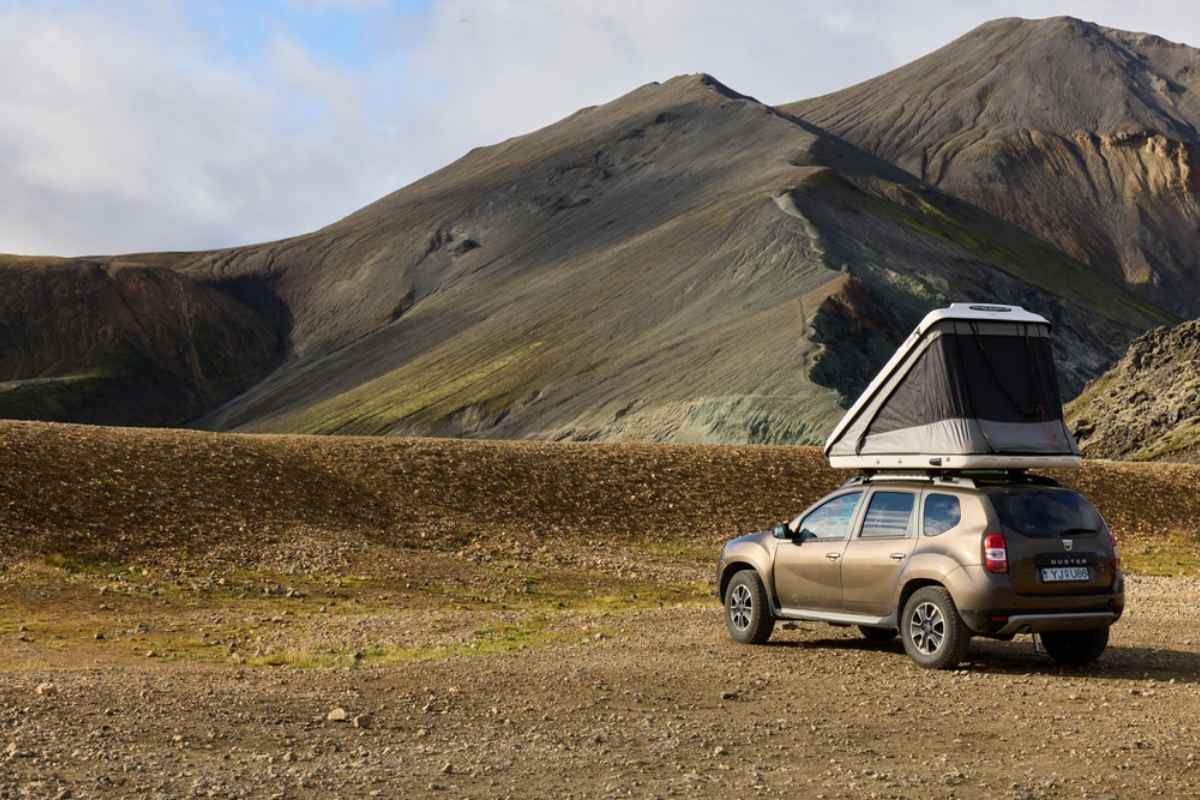
The Must-See Waterfalls in Iceland
Our country has so many waterfalls that after a while, you might start thinking, 'Oh, another ridiculously beautiful cascade? Yawn.' But trust us, Iceland's waterfalls never get old. Here are the absolute best waterfalls in Iceland you can not miss:
Gullfoss – The Iconic Golden Circle Waterfall
If you are driving Iceland's Golden Circle, you cannot miss Gullfoss. The water does not just fall. It charges off a cliff in two stages before vanishing into a canyon-like it is trying to escape. The first drop is 11 meters (36 feet), then it takes another 21-meter (69-foot) plunge, adding up to 32 meters (105 feet) of pure power.
You will hear it before you even see it, and once you do, it is hard to look away. The name Gullfoss, meaning 'Golden Waterfall,' has unclear origins. Some say it is because of the golden glow the water gets in the sunlight.
Others claim it is tied to a Viking named Gygur, who allegedly threw his gold into the falls so no one else could have it. On sunny days, rainbows form in the mist. On windy days, expect your hat to fly straight into the canyon.

Seljalandsfoss – The Waterfall You Can Walk Behind
Ever wanted to walk behind a waterfall? Great. Ever wanted to get completely drenched while doing it? Even better. Seljalandsfoss lets you do both. The water drops 60 meters (197 feet) straight down, and there is a path that takes you right behind it.
This used to be part of Iceland's coastline until the land decided to shift, leaving the waterfall stranded inland. Now, it is just sitting there, looking all photogenic while soaking unprepared tourists.
Here's a tip for you: Bring a rain jacket. Otherwise, you will walk out looking like you lost a fight with a garden hose.
Skogafoss – One of Iceland's Most Powerful Waterfalls
At 60 meters (197 feet) high and 25 meters (82 feet) wide, Skogafoss does not just fall. It literally annihilates everything below it. The mist is so intense that getting close means risking your camera's survival. That being said, it is totally worth it.
According to legend, Viking Þrasi Þórólfsson hid a chest of gold behind Skogafoss. Apparently, someone once found the chest but only managed to grab the handle before it disappeared forever. (Personally, we think the Viking just made the story up to mess with people.)
You can either stand at the bottom and get wet. Or you could take the 370-step hike up to the viewing platform for a breathtaking panorama view.

Godafoss – The Waterfall of the Gods
Godafoss looks peaceful now, but back in the year 1000, it was basically Iceland's official trash bin for the old gods. Godafoss actually translates to 'Waterfall of the Gods' and is of great cultural significance to Icelanders.
A chieftain named Þorgeir Ljósvetningagoði made the call to ditch old Norse beliefs and convert to Christianity. To prove he meant business, he grabbed his pagan idols and chucked them straight into the falls. A bit dramatic? Yes. Effective? Apparently. The waterfall itself is 30 meters (98 feet) wide and 12 meters (39 feet) high, curving into a perfect horseshoe shape.
The water? Ridiculously blue. Almost fake-looking. It is part of the Diamond Circle, so it is an easy stop if you are road-tripping the north. The best time to visit is late afternoon when the light hits the water just right.

Dettifoss – Europe's Most Powerful Waterfall
Some waterfalls are soothing. Dettifoss is not. It is loud, it is aggressive, and it will shake the ground beneath your feet. It also famously holds the title of Europe's most powerful waterfall.
At 44 meters (144 feet) high and 100 meters (328 feet) wide, it hurls more than 11 million liters of water every minute into the canyon below. The sound is deafening. The mist? Non-stop face slaps. If you wear glasses, prepare to wipe them every five seconds.
It is fueled by Vatnajökull, Iceland's biggest glacier, so it never slows down. If you have seen Prometheus, you might recognize it. Apparently, Ridley Scott took one look at Dettifoss and thought, 'Yeah, that belongs in an alien movie.' Take note not to wear anything you actually like. It will get soaked.
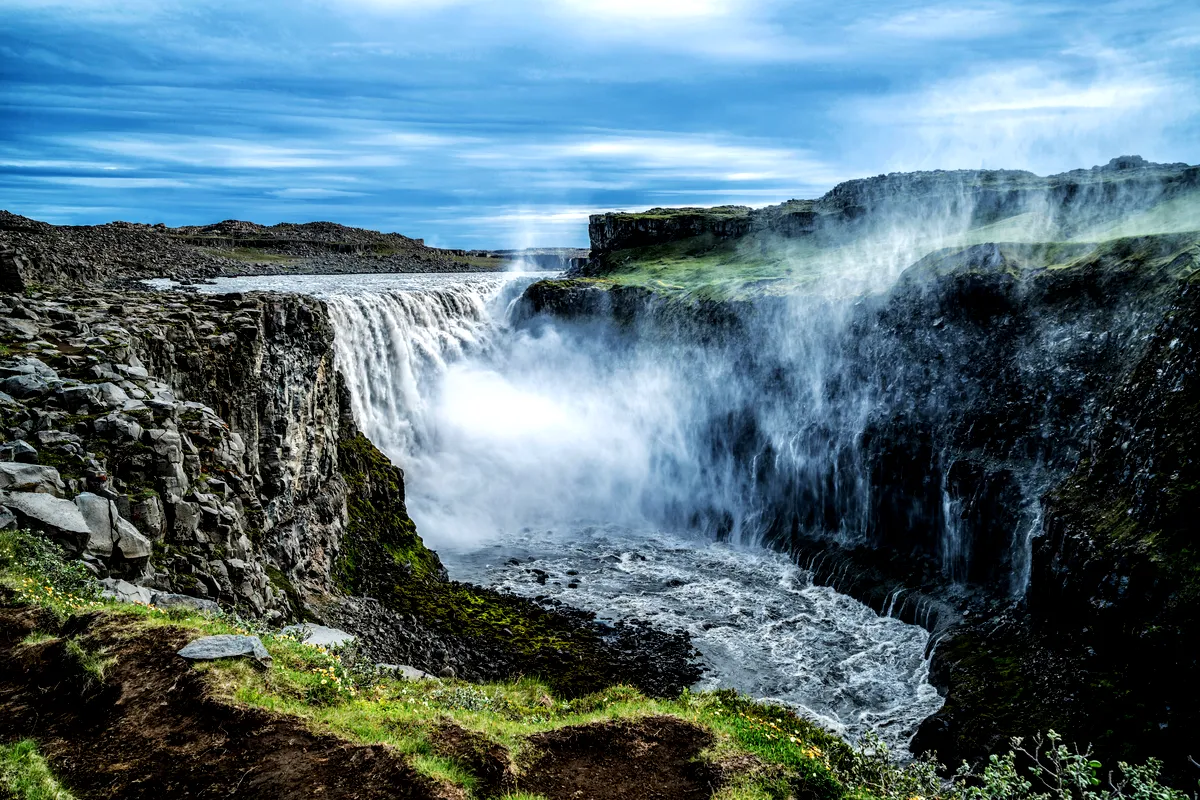
Svartifoss – The Black Basalt Column Waterfall
Svartifoss is another beautiful waterfall that drops down 20 meters (66 feet), but the real show is the backdrop. It is framed by black basalt columns that look like they were carefully placed there by a giant troll with OCD.
The waterfall was formed by lava cooling into this geometric masterpiece we have today. These formations were even the inspiration behind the iconic Hallgrímskirkja church in Reykjavík.
To get here, you have to hike 5.5 kilometers (3.4 miles) round trip. The trail is easy, and the views along the way make it worth it.

Dynjandi – The Westfjords' Cascading Beauty
Dynjandi could not decide on a shape, so it became several waterfalls at once. It starts 30 meters (98 feet) wide at the top and expands to 60 meters (197 feet) at the bottom, cascading 100 meters (328 feet) down like a massive, multi-tiered wedding cake.
Some say it looks like a bridal veil. Others think it is more of a staircase made of water. The best part about this waterfall is there are almost no crowds. Dynjandi is in the Westfjords, far from the usual tourist traps.

Glymur – Iceland’s Second Tallest Waterfall
For years, Glymur was thought to be the tallest waterfall in Iceland, standing at 198 meters (650 feet). Then, some researchers found a taller one called Morsárfoss, which is 228 meters (748 ft) tall. The problem?
Morsárfoss is basically impossible to reach unless you take a helicopter. So, technically, Glymur is still the tallest waterfall that actually matters. Getting here is not a walk in the park.
The 7-kilometer (4.3-mile) hike involves river crossings, steep climbs, and zero guardrails. Expect to hike for around 3-4 hours to reach this waterfall.
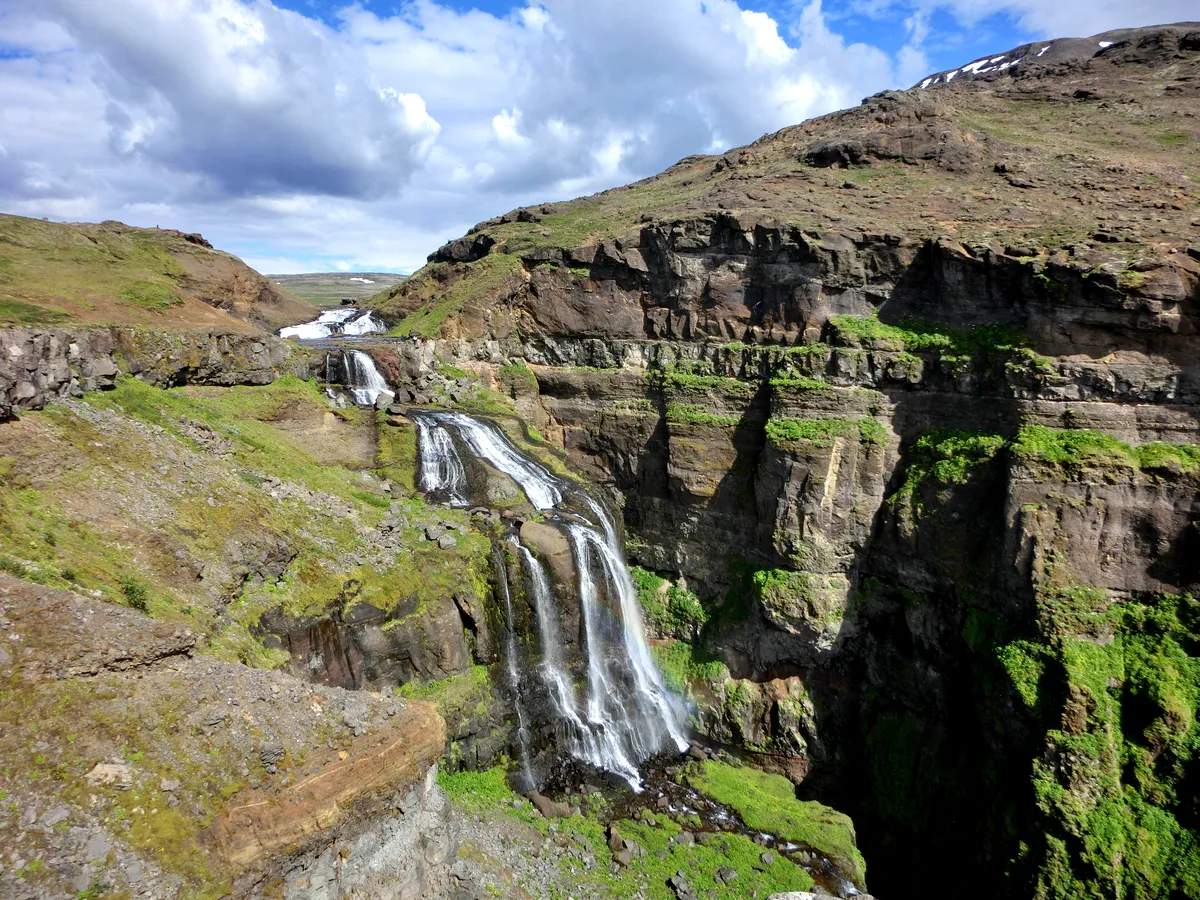
Off-the-Beaten-Path Waterfalls for Adventurous Travelers
If you are willing to go a little off the main roads, you will find some other famous Iceland waterfalls that are still relatively untouched. These spots do not have tourist buses lined up, and that is exactly what makes them worth the effort.
Kvernufoss – A Hidden Gem Near Skogafoss
You would think a 30-meter (98-foot) waterfall this stunning would be packed with people, but somehow, Kvernufoss flies under the radar. It is right next to Skogafoss, yet barely anyone bothers to visit.
The walk to get there is easy and takes you through a moss-covered canyon that looks straight out of a fantasy film. When you arrive, you can actually walk behind the waterfall, which is something you cannot do at a lot of Iceland's bigger falls. The mist will soak you, but honestly, that is part of the fun.
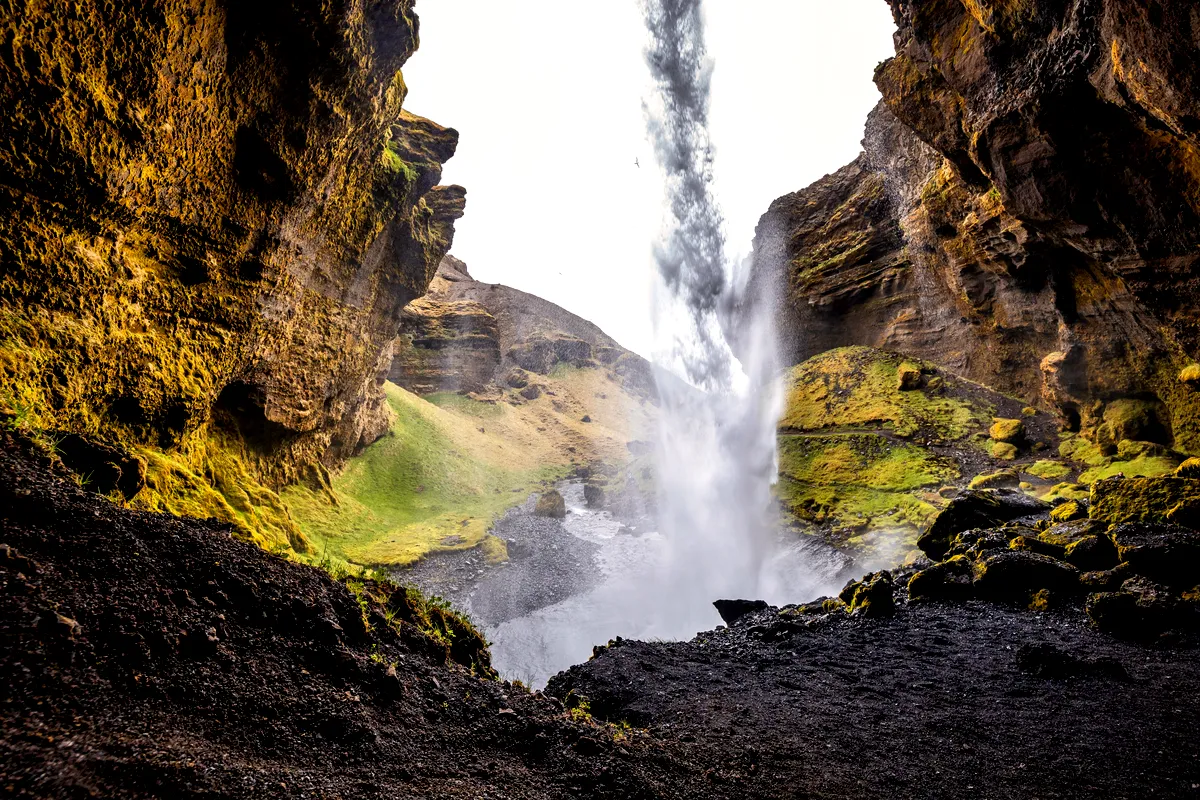
Haifoss – A Stunning High Waterfall in the Highlands
Haifoss does not do 'small.' The name translates to 'High Waterfall,' and it lives up to its name. The drop is a massive 128 meters (420 feet). But it does not stop there. The way the water launches off the cliff makes it look like it is getting thrown down instead of just falling.
The best part? It is not alone. Right next to it is Granni, a second waterfall that makes the whole landscape look surreal. Together, they create a canyon view that will make you forget to take photos for a second because you are too busy staring.
Getting there is a bit more tricky. You need a 4x4 vehicle, and the road is, let's just say, 'rough' in the way that Icelandic highland roads tend to be. But that keeps the crowds away, meaning you get one of the best views in Iceland without the usual tourist chaos.
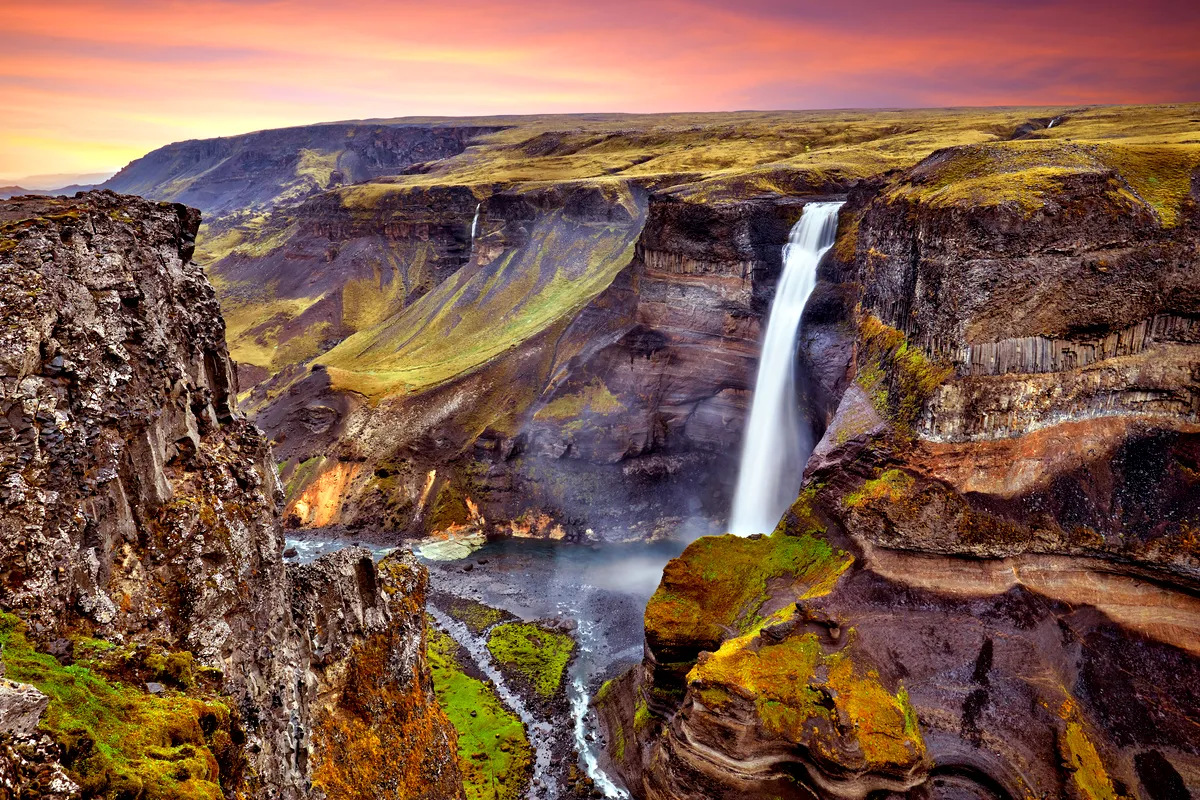
Bruarfoss – The Brilliant Blue Waterfall
Bruarfoss has got to be one of the best waterfalls in Iceland. You simply can not skip it. This waterfall is not about height or power. It is about that insane blue color. The water here is the kind of bright, almost unnatural shade of blue that makes people assume you photoshopped it. But nope, that is just what happens when glacial meltwater mixes with volcanic rock.
Instead of one big waterfall, it is a series of small cascades that rush through a dark basalt riverbed. The contrast makes the color pop even more. The name means 'Bridge Waterfall,' though the original natural stone bridge collapsed centuries ago. Now, there is just a wooden footbridge, which still offers a great view.
The hike to get there takes about 45 minutes, which is why a lot of people skip it. If you go early in the morning, then there is a good chance that you might have this unreal scene all to yourself.

Hengifoss – A Geological Marvel with Red Rock Layers
Hengifoss is the kind of waterfall that makes geologists freak out. Sure, it is 128 meters (420 feet) tall, making it one of the tallest in Iceland, but the real show is the cliff behind it. The rock face is streaked with bold red clay layers, which are millions of years old. The contrast between the dark basalt and red bands makes the whole thing look otherworldly.
The name 'Hengifoss' means 'Hanging Waterfall,' which makes sense when you see how the water seems to hover before making its drop. The hike to reach it is about 2.5 kilometers (1.5 miles) and takes around 45 minutes, depending on how many times you stop to admire the view.
Along the way, you will pass Litlanesfoss, a smaller waterfall surrounded by impossibly tall basalt columns. By the time you reach Hengifoss, you will feel like you stepped onto another planet. If you go when the sky is cloudy, the whole place looks even more amazing.
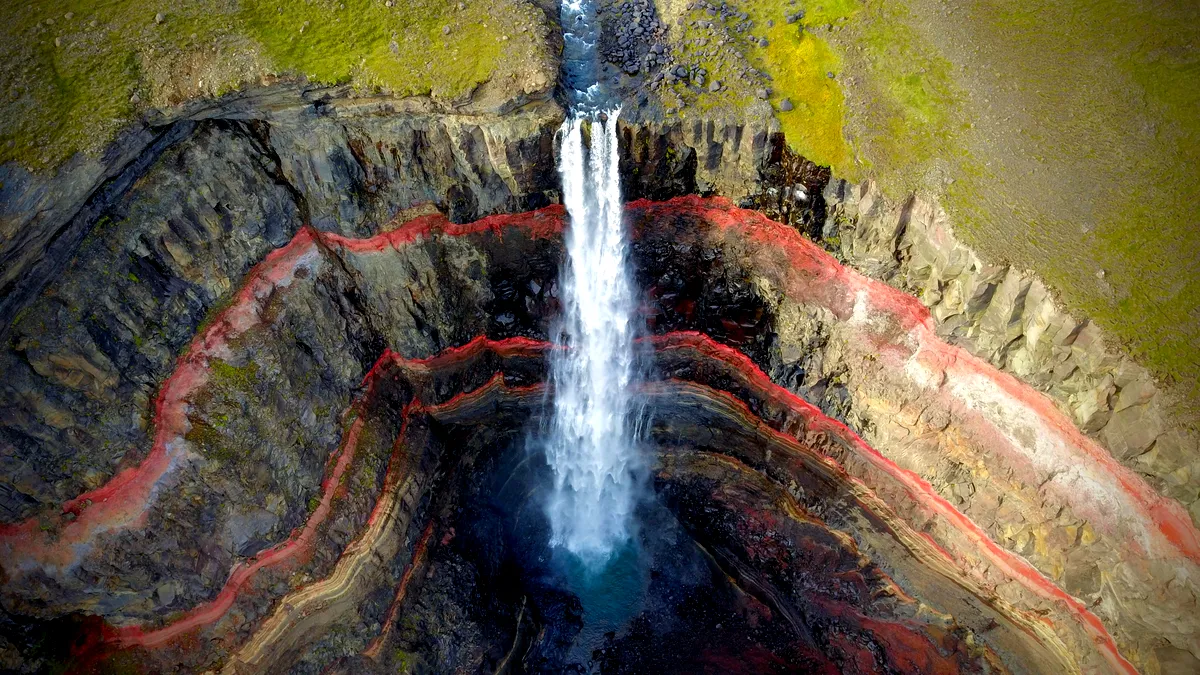
Driving Tips for Visiting Iceland's Waterfalls
Driving in Iceland might be a bit different from what you are used to back home. If you are heading out to chase waterfalls, here is what you need to know before hitting the road.
- Stick to the speed limits – Iceland's government loves speed cameras almost as much as they love collecting the money from the fines. The cameras are everywhere, and the fines are brutal. If you do not want your rental bill to come with an extra surprise, keep an eye on the signs.
- Gravel roads are waiting to test your patience – Some of the best waterfalls in Iceland are tucked away down unpaved roads that will rattle your bones (and your car). Take it slow, keep a firm grip on the wheel, and be prepared for passing cars to shower you with loose gravel. Rental companies love charging for chipped paint and cracked glass, so do yourself a favor and take out gravel protection.
- Check road conditions before you go – Icelandic weather changes whenever it feels like it, and roads close without much warning. Before you head out, check the Icelandic Road and Coastal Administration website for updates. A quick look might save you from turning your road trip into an unexpected off-road survival course.
- Fill up your tank – Some of these waterfalls are far from civilization. If you assume there will be a gas station nearby, you are playing a risky game. Top up whenever you get the chance unless you enjoy sweating over your fuel gauge in the middle of nowhere.
- Thinking of the Highlands? Get a 4x4 – If your itinerary includes any roads marked with an 'F' (F-roads), you legally need a 4x4. These roads are rough, full of river crossings, and absolutely not designed for tiny rentals. Do yourself a favor and get a vehicle that can handle the terrain. A good all-rounder, such as the famous 4x4 Dacia Duster campervan, will do the trick.

Parking and Campervan Regulations Near Waterfalls
We Icelanders take great pride in protecting our fragile nature. Thus, we also have some strict rules that you need to be aware of. Ignoring them might get you a fine or a very unfriendly conversation with the locals.
- Use designated parking areas – Most waterfalls have official parking spots. They are marked, sometimes require a small fee, and are infinitely better than just pulling off to the side of the road. Many people use apps like Parka or EasyPark, so download one before your trip.
- No wild camping – The days of pitching a tent wherever you like are long gone. Unless you have specific permission from a landowner, you need to stay in a designated campsite. (For more details, check out this article about Iceland's camping rules.)
- Respect private land – A lot of Iceland is privately owned, even the land around waterfalls. Do not assume you can park anywhere just because it looks empty. If you park somewhere you are not supposed to, expect a fine or an angry Icelandic farmer knocking on your van.
Best Campsites Near Waterfalls for an Overnight Stay
If you are traveling in a campervan, these campsites put you right next to some of Iceland's most famous waterfalls.
- Skaftafell Campground – If you are heading toward Vatnajökull National Park, this is the place to stay. It is surrounded by glaciers and waterfalls, so expect some ridiculously good views with your morning coffee.
- Faxi Waterfall Campsite – A quieter spot near Faxi waterfall, great if you want to escape the tourist-packed Golden Circle stops. You can even try fishing in the nearby river if you need a break from driving.
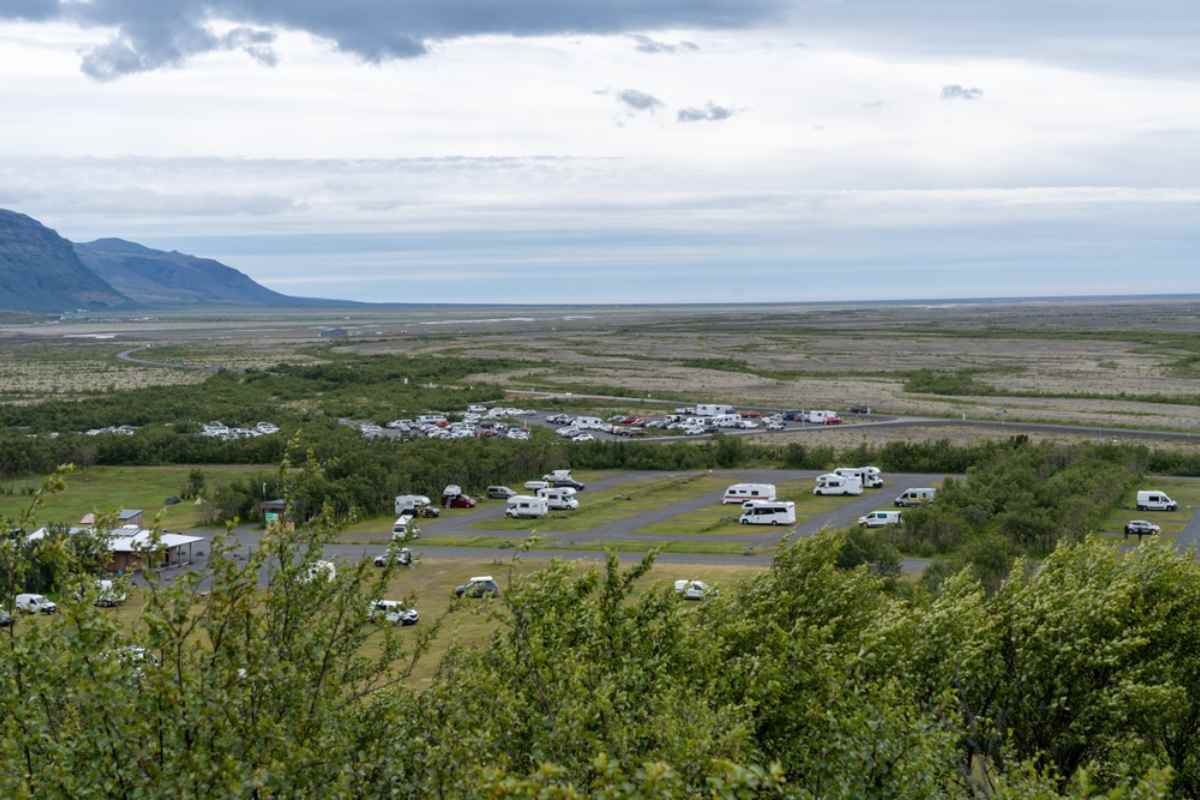
Final Tips for a Waterfall Road Trip in Iceland
Before you hit the road, here are a few final things to keep in mind. A little preparation goes a long way when you are driving through Iceland's wild landscapes, especially when chasing waterfalls that are miles away from the nearest town.
- Vehicle Maintenance Matters – Make sure your campervan is in good shape before heading off on long drives. Check the tires, brakes, and fluid levels, and always start with a full tank of gas. If you are traveling in winter, your rental should come with winter tires (if you rent a campervan through us, this is included at no extra charge). The last thing you want is to get stuck in a snowstorm with the wrong tires.
- Bring an Emergency Kit – Keep a first aid kit, flashlight, extra layers, and warm clothing in your campervan. If your route takes you into remote areas, a portable battery charger and a backup map (yes, a paper one) is a good idea. Cell service is not always reliable, and getting stranded with a dead phone is not ideal.
- Know a Few Icelandic Words – Most Icelanders speak English, but a few local words can be useful (and appreciated). Keep these in mind: Takk (thank you), Godan daginn (good day), Hvar er...? (where is...?), Bensinstod (gas station), and Vedurspa (weather forecast).
- Stock Up on Groceries – Once you leave major towns, supermarkets get scarce. Stock up when you can, especially on essentials like snacks, water, and coffee. Bonus and Krónan are the cheaper grocery store chains. If you are relying on your campervan's kitchen, make sure you have enough propane or fuel for cooking.
- Book Campsites in Advance – During peak season, campsites fill up fast. If you have a specific area in mind, book ahead to avoid getting stuck with an overbooked campground.
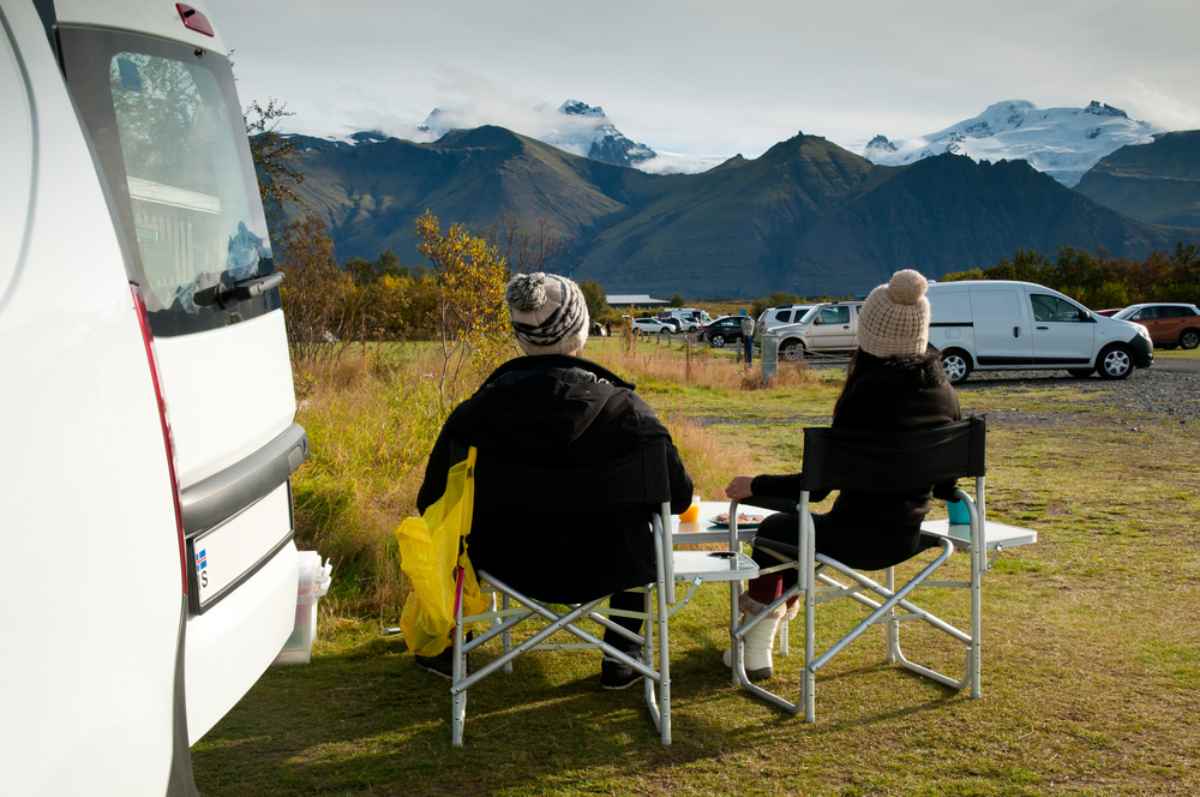
Frequently Asked Questions
Do you need a 4x4 to visit some waterfalls?
Not all, but some waterfalls, like Haifoss and those in the Highlands, require a 4x4 due to rough gravel roads. For remote locations, a standard rental car will not cut it.
How many waterfalls are in Iceland?
Iceland has over 10,000 waterfalls, with new ones forming as glaciers melt. Many remain unnamed, while famous ones like Gullfoss, Skogafoss, and Seljalandsfoss draw thousands of visitors each year.
What is the most beautiful waterfall in Iceland?
Beauty is subjective, but our personal favorites are Gullfoss, Dynjandi, and Bruarfoss.
Do Iceland waterfalls freeze in winter?
Some do. Aldeyjarfoss, Kirkjufellsfoss, Svartifoss, and parts of Gullfoss often freeze, creating dramatic ice formations. Others, like Dettifoss, keep flowing but are surrounded by thick ice and snow.
Is it safe to drink waterfall water in Iceland?
Generally, yes, if it comes from a clean, glacial source. However, avoid drinking near farms or downstream areas where contamination from animals or humans could be an issue.
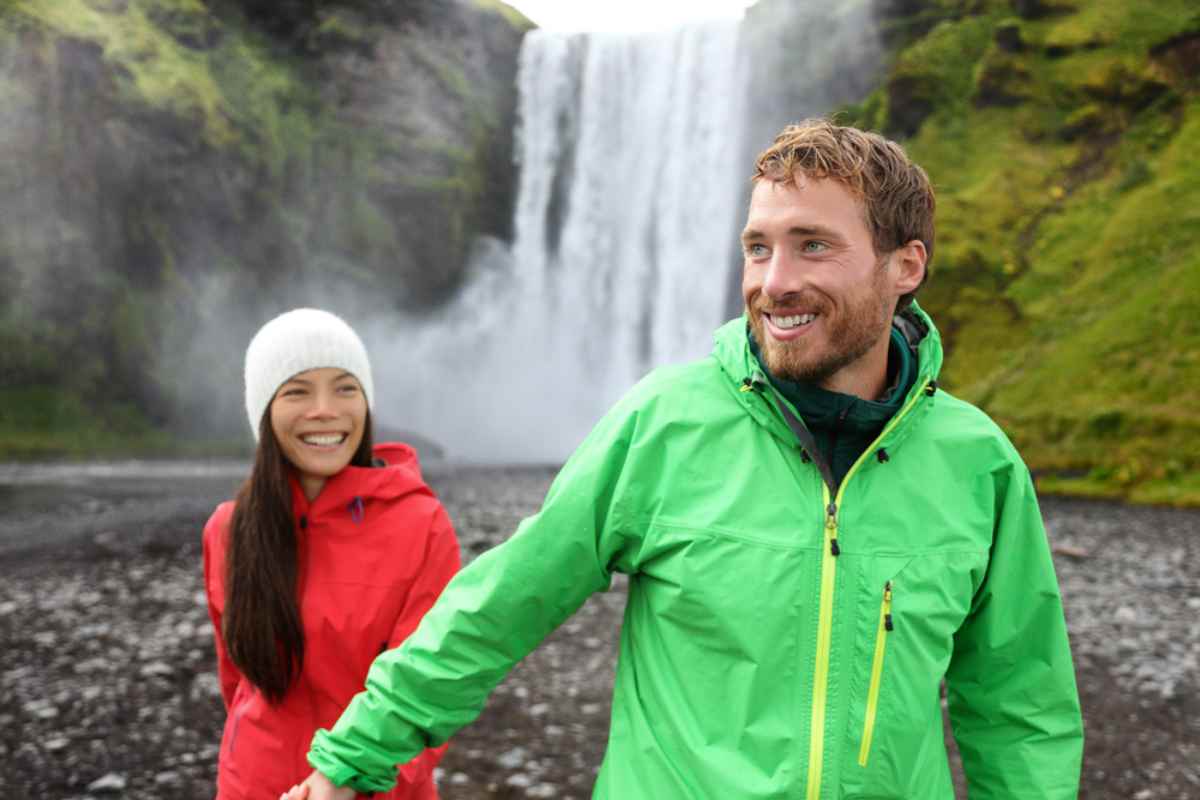
Your Next Steps for Seeing the Best Waterfalls in Iceland
Exploring the best waterfalls in Iceland is an experience you will never forget. From massive, thundering cascades to hidden gems tucked away in remote canyons, each one has something unique to offer.
Renting a campervan in Iceland is the best way to see them all at your own pace without worrying about rigid schedules. So, if you are planning your trip, then please feel free to reach out to us with any questions.
We are always happy to assist in whatever way we can to make your visit as smooth and unforgettable as possible.
